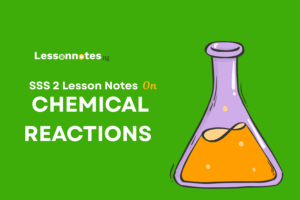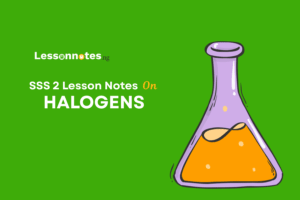Thermodynamics SS2 Chemistry Lesson Note
Download Lesson NoteTopic: Thermodynamics
THERMODYNAMICS
Thermodynamics is the study of the relationship between heat and other forms of energy.
A system in thermodynamics is any part of the universe chosen for thermodynamics consideration, i.e. the physical and chemical phenomenon or process occurring in a given environment.
A system can be isolated, closed or open. Surrounding is the environment in which a phenomenon or a process occurs.
The first law of thermodynamics states that energy can neither be created nor destroyed but may be converted from one form to another.
In thermodynamics, heat is represented by q and other forms of energy are referred to as work denoted by w. The conditions or state of a chemical system is changed when:
- Heat is evolved or absorbed, and/or
- Work is done on or by the system
In any case, the internal energy, U, of the system is affected and it is changed.
From the first law, heat is changed into internal energy of the system it may be represented by a change in internal energy = Heat absorbed by the system + Work done by the system
i.e. U = q + w
Work done by the system is negative since this leads to a decrease in internal energy, therefore:
U = q – w
For a gaseous system, w = P V
U = q – P V
U = H – P V
H = U – P V
SECOND LAW OF THERMODYNAMIC
The second law of thermodynamics states that a spontaneous process occurs only if there is an increase in the entropy of a system and its surroundings.
Factors which determine the spontaneously of a process are:
- enthalpy, H: The heat content of the substances involved
- entropy, S: The measure of the degree of disorderliness or randomness of a substance
- free energy G: The energy which is available for doing work.
- Entropy (S)
Entropy is the measure of the degree of disorderliness or randomness of a system. The standard entropy change (∆Sθ) is a state function because it depends on the initial and final state of the system. That is:
∆Sθ = Sθproducts – Sθreactants
The SI unit is JK-1mol-1
Entropy increases from solid to liquid to gaseous state because as you go from solid to liquid to gaseous state, randomness increases, that is; ∆Sθ tends to be positive.
For a reversible process at a constant temperature,
S = H/T
When ∆S is positive, there is an increase in entropy. When ∆S is negative there is a decrease in the entropy of a system.
2. Gibbs Free Energy
The free energy of a system is the energy which is available for doing work in the system; that is, the driving force that brings about a chemical change.
The standard free energy change (∆Gθ) is a state function because it depends on the initial and final state of the system. That is:
∆Gθ = Gθproducts – Gθreactants
Free energy takes into account the effect of the enthalpy and entropy factors as represented in the equation below:
G = H-TS
For a change at a constant temperature,
G = H – T S
NOTE:
- When G is negative, the reaction is spontaneous or feasible.
- When G is positive, the reaction is not spontaneous, unless the resultant effect of both H and S leads to a net decrease in G
- When G is zero, the system is in equilibrium
Example:
The reaction:
C(s) + O2(g) > CO2(g)
Is carried out at a temperature of 57oC. If the enthalpy change is -500J and the entropy change is +15J. Calculate the free energy change
Solution:
G = H – T S
= -5000 – (57 + 273) x (+15)
= -5000 – 330 x 15
= -5000 – (+4950)
= -5000 – 4950
= -9950J or -9.950kJ






















